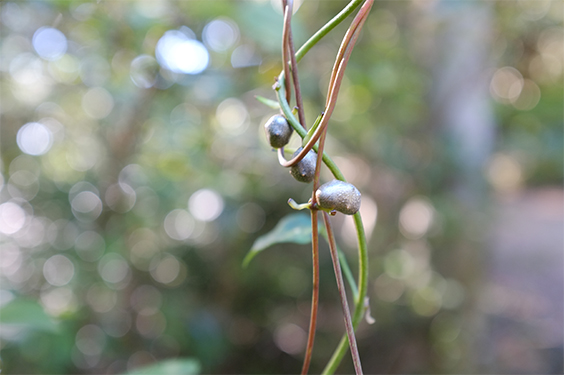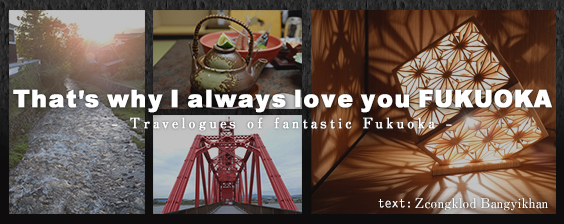- Home
- feature
- That's why I always love you F...
- That's why I always love you F...
That's why I always love you Fukuoka by Zcongklod Bangyikhan #05 Sasaguri – Walk the Historic Temples, Unwind in the Calming Forests(3/4)
Forest Therapy Sasaguri (篠栗森林セラピー基地)
Sasaguri is 70% forest. I’m extremely tempted to take a forest tour, but just strolling through a forest doesn’t quite cut it as a tourist attraction these days. That’s why the town has teamed up with local tourism ventures to establish “forest therapy.” I decided to try the “Sasaguri Kyudai no Mori Course,” which is a course planned and surveyed by the town of Sasaguri and Kyushu University.
There are 5 other walking courses in different areas around Sasaguri. They are all free to walk and enjoy, but you can also request a forest guide (called a “mori no annai-bito”) to go with you and they will tell you about the area and show you all the highlights along the way. Guides must be booked in advance and costs 1500 Yen per person for groups of 4 people or more.
Nature walks really aren’t that different in Japan, Thailand, or anywhere else in the world. However, here, instead of saying you “learn” about nature, they call it “therapy.” So I was intrigued as to just what this “therapy” was referring to or how being in the middle of a forest was supposed to be relaxing.
Before setting out on the 2km course, the two guides asked us about our physical condition. They then told us to turn off our mobile phones before entering the forest to best relax our five senses. Other than that the rest of the instructions were fairly standard for a trekking tour.
At the beginning of the course we were instructed to take three deep breaths. This was to inhale fresh air and relax us, but also, to consign ourselves over to nature.













Walking along, our guides provided us with scientific explanations of all the different trees as well as cultural knowledge and how nature is connected with Japanese culture. For example, leaves of the urajiro tree are used to adorn mochi rice cakes at New Years, and this is done so because the underside of the leaf is white, meaning it has “no darkness behind it” and thus “pure,” which is how the leaf came to be used today as a good omen. We also got to try fruits and seeds of various trees, and we learned about geology from looking at fossilized trees.
One thing that I really liked was all the woodchips that had been laid out along course. This made walking easier and the chips gave off a natural smell of wood as we walked over them. It is believed that such aromas heighten the relaxation effect, improving health and helping to alleviate illness.






After walking for a while we came to an arbor where we sat down and the guides provided us with some sweets and green tea that they had prepared. Then they passed around small bags asking us, “Why not collect some things to make a bookmark as a memento of your time in this forest?” In Thailand, we’re told that it’s not good to take things home from the forest, so this was a first for me. I could only see pine trees, grass and flowers around me, so I grabbed a green foxtail that looked like it would fit inside a bookmark. Of course you can’t just pick anything you want from the forest; for “bookmark making” the general rule is to only use things that have already fallen to the ground, like leaves and twigs. The point is not to destroy nature, but to not let people forget how close we are to nature.
At the end of our forest therapy, the guides laid out a plastic sheet by a large tree and said, “Lie down looking up at the sky and try to feel the nature around you with your body.” By looking at nature from a different angle, they believe that people’s view of nature will change.
It’s hard to describe forest therapy in words. What I can say, though, is that Japanese people put effort into even the smallest parts of daily life and can see the value in it, and it’s clear that they know that man and nature coexist.
Walking through the forest is not just observing nature for them; it’s coexisting. They go into the forest so that nature, in turn, will circulate through them.
As we return to the starting point and we’re about to depart, I inhale deeply three more times, hoping to retain the forest air inside me just a little bit longer.
There are 5 other walking courses in different areas around Sasaguri. They are all free to walk and enjoy, but you can also request a forest guide (called a “mori no annai-bito”) to go with you and they will tell you about the area and show you all the highlights along the way. Guides must be booked in advance and costs 1500 Yen per person for groups of 4 people or more.
Nature walks really aren’t that different in Japan, Thailand, or anywhere else in the world. However, here, instead of saying you “learn” about nature, they call it “therapy.” So I was intrigued as to just what this “therapy” was referring to or how being in the middle of a forest was supposed to be relaxing.
Before setting out on the 2km course, the two guides asked us about our physical condition. They then told us to turn off our mobile phones before entering the forest to best relax our five senses. Other than that the rest of the instructions were fairly standard for a trekking tour.
At the beginning of the course we were instructed to take three deep breaths. This was to inhale fresh air and relax us, but also, to consign ourselves over to nature.













Walking along, our guides provided us with scientific explanations of all the different trees as well as cultural knowledge and how nature is connected with Japanese culture. For example, leaves of the urajiro tree are used to adorn mochi rice cakes at New Years, and this is done so because the underside of the leaf is white, meaning it has “no darkness behind it” and thus “pure,” which is how the leaf came to be used today as a good omen. We also got to try fruits and seeds of various trees, and we learned about geology from looking at fossilized trees.
One thing that I really liked was all the woodchips that had been laid out along course. This made walking easier and the chips gave off a natural smell of wood as we walked over them. It is believed that such aromas heighten the relaxation effect, improving health and helping to alleviate illness.






After walking for a while we came to an arbor where we sat down and the guides provided us with some sweets and green tea that they had prepared. Then they passed around small bags asking us, “Why not collect some things to make a bookmark as a memento of your time in this forest?” In Thailand, we’re told that it’s not good to take things home from the forest, so this was a first for me. I could only see pine trees, grass and flowers around me, so I grabbed a green foxtail that looked like it would fit inside a bookmark. Of course you can’t just pick anything you want from the forest; for “bookmark making” the general rule is to only use things that have already fallen to the ground, like leaves and twigs. The point is not to destroy nature, but to not let people forget how close we are to nature.
At the end of our forest therapy, the guides laid out a plastic sheet by a large tree and said, “Lie down looking up at the sky and try to feel the nature around you with your body.” By looking at nature from a different angle, they believe that people’s view of nature will change.
It’s hard to describe forest therapy in words. What I can say, though, is that Japanese people put effort into even the smallest parts of daily life and can see the value in it, and it’s clear that they know that man and nature coexist.
Walking through the forest is not just observing nature for them; it’s coexisting. They go into the forest so that nature, in turn, will circulate through them.
As we return to the starting point and we’re about to depart, I inhale deeply three more times, hoping to retain the forest air inside me just a little bit longer.
Forest Therapy Sasaguri (篠栗森林セラピー基地) Sasaguri Kyudai no Mori Course
Address: 1009 Wada, Sasaguri-machi, Kasuya-gun, Fukuoka-ken
Access: Alight at JR Sasaguri Station. 10 minute taxi ride to your destination.
Website: http://www.sasaguri-therapy.jp/
Access: Alight at JR Sasaguri Station. 10 minute taxi ride to your destination.
Website: http://www.sasaguri-therapy.jp/
 Measures and provisions are being taken at various locations in an effort to prevent the spread of the new coronavirus.
Measures and provisions are being taken at various locations in an effort to prevent the spread of the new coronavirus.















